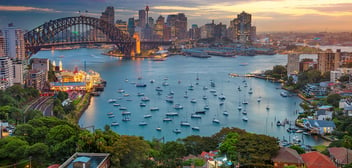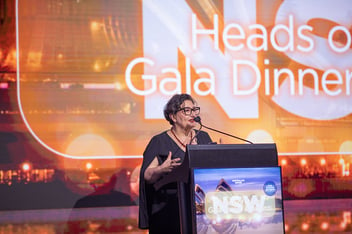Progress and Challenge in our Shared Water Future
A passionate Canberrian and past president of the AWA ACT Branch, Adrian Piani delivered the keynote address for this year’s ACT Water Matters Conference.
Adrian is the GHD Market Leader with over 25 years extensive experience in the water and sustainability sector, including advising the Australian Government on its multibillion-dollar 'Water for the Future' program and leading the Australian Sustainable Built Environment Council Resilience Task Group.

“We are truly lucky to be working in this sector,” said Adrian.
“As the ACT Chief Engineer, I had a responsibility to deliver much of the infrastructure that supports our community here in Canberra. But I felt I also had a broader role to consider what makes Canberra such a great place, what are the big risks that could impact us, and subsequently, how we best plan for the long term”.
Adrian discussed the different types of infrastructure including economic, social, green and blue to take a big picture view of the challenges within each.
“Economic infrastructure supports all our activities. That is our essential services including transport, water and sewer, energy and waste management. We have social infrastructure, which enables provision of specific services to communities such as schools and hospitals. [we also] have green and blue infrastructure, which provides ecosystem services and contributes to our overall wellbeing and mental health.” Said Adrian.
“Long term systematic focus will be needed for what I termed the big three. Energy, Transport and Water”.
Switching off the fossil fuel gas network and replacing that energy supply with electricity is a significant undertaking, which the ACT government and Evo Energy is now starting to plan.
“It's a 20-year journey, which requires a strategic approach to augment the electricity system to meet increased demands whilst minimising disruption to our community.” Said Adrian.”
“Our transport transformation is maintaining a town that is easy to move around whilst our population grows, and this is a substantial challenge for us. We now have light rail as part of that journey, but also a considerable transformation in how we consider the road network, urban density and urban planning”.
For Canberra, this transformation is leading to density with less greenfields development and more infill development and an ongoing public dialogue to ensure the benefits of this are understood and valued by the community, as well as thoughts and planning to ensure those benefits are delivered.
Abundance vs. Drought
“One of the reasons we're gathered here today on Ngunnawal Country is because the abundant water resources of this area were seen as vital to support our new nation.” Said Adrian.
“Located adjacent to the three separate water sources of Murrumbidgee, the Cotter and the Queanbeyan Rivers. It's the location that enabled water resource planners to tap into a variety of sources and ensure a relatively robust water supply.
A few droughts have occurred in the area since and as the populations grows, so too does the demand for water. Historical analysis indicates that southeast Australia experienced 27 drought years between 1788 and 2000, and at least 10 major droughts.
“I can't help but think our next big drought will be our worst and as a water professional it's our job to consider the worst and be prepared for it.” Said Adrian.
Recently published work from the ANU Institute for Climate, Energy and Disaster Solutions showed that it was possible that we've had droughts that lasted 20 years in the past. With climate change, it was more likely that we would experience these in the future. With that in perspective the millennium drought lasted only 8 years.
“So perhaps we should be adopting this as our worst-case scenario and planning for it now.” Said Adrian.
“Increasing demand, reduced supply. How do we best manage our scarce water resource in this scenario? The last time we invested in several innovative and significant water supply measures including an enlarged water dam and a transfer system from the Murrumbidgee and a stormwater harvesting system in the inner north with managed aquifer recharge”.
As a sector, we solve some very challenging problems.
Social license vs. community confidence
“We've seen other sectors miss the importance of social licenses to their business and what can happen when it's taken for granted”, said Adrian.
“A leading global mining group for instance destroying Aboriginal heritage mistakenly believing [that] because it was legal, it was ok. The energy sector has experienced significant community backlash against the construction of new transmission lines that are required for a Net Zero energy sector even though this would have been considered as a BAU exercise. If we are to contemplate the creation of a new water source based on treated purified water, I suspect that the biggest hurdle will be gaining community acceptance”.
Adrian reiterated that despite challenges and recent examples of backlash and misunderstandings, he is confident that the community will support a choice which enables them to access water, even during the largest droughts.
“I advocate a steady-stage strategic approach that brings community and stakeholders on the journey and positions them to better understand and hopefully support big decisions when they are made,” said Adrian.
“Our understanding of community views and sensitivities is broader than a conversation about purified recycled water and extends to many areas where a high level of service is expected, and stewardship of our environment is demanded.”
Adrian referenced these items including quality of water in the ACT waterways, the ability of watercourses to provide for recreational pursuits, the management of exotic pest plants and animals, meeting effluent discharge guidelines, control of sewage overflows and the maintenance of environmental flows to support river health.
“As water professionals, it’s sometimes easy to miss changing customer and stakeholder perceptions as we become normalised to our standing operating procedures. Ongoing vigilance, questioning and observance of social trends is vital to ensure as a sector [that] we maintain our social license,” said Adrian.
“As always an integrated view of our water cycle promotes the best outcomes”.







